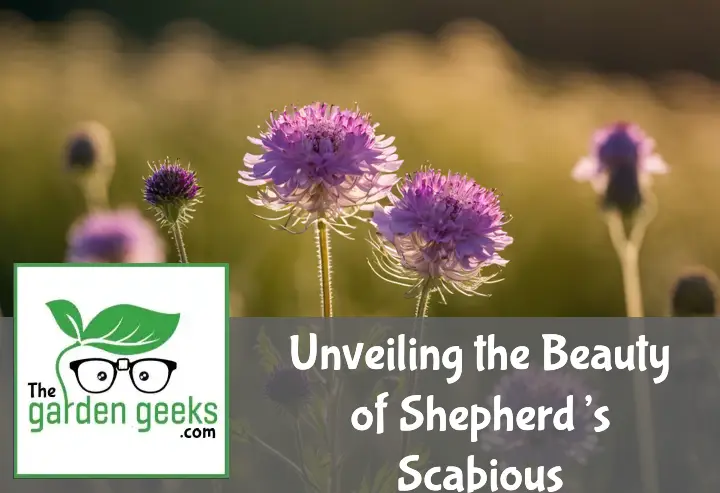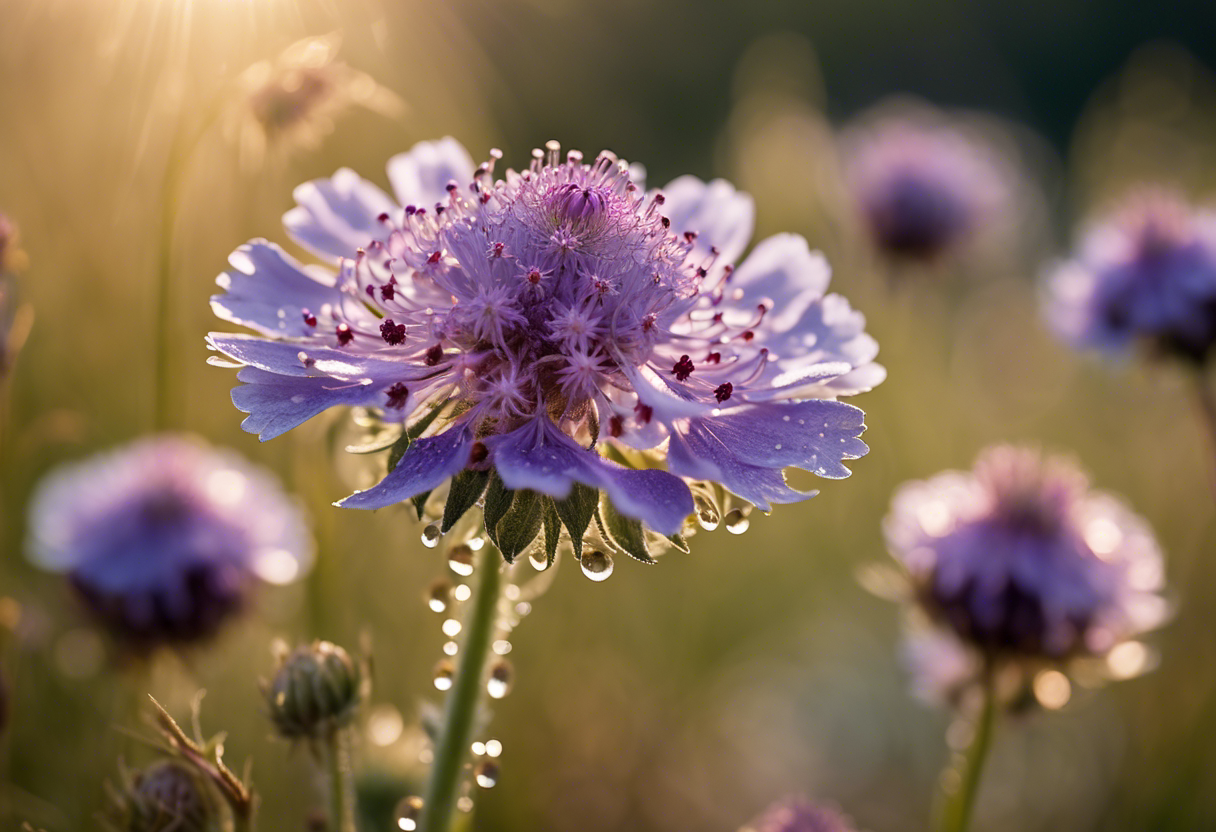Ever stumbled upon a flower so beautiful it made you stop in your tracks? Well, that’s exactly what happened to me the first time I laid eyes on the Shepherd’s Scabious. This stunner of a plant is far from your run-of-the-mill garden variety.
Now, don’t get me wrong. I’m not saying all other flowers are ‘meh’. But there’s just something about Shepherd’s Scabious that sets it apart. Maybe it’s its unique floral structure or the spectrum of colors it flaunts. So, buckle up folks! We’re about to dive into unveiling the beauty of Shepherd’s Scabious.
Key Takeaways
- Shepherd’s Scabious is a beautiful perennial plant native to Europe.
- It has large, blue-purple flowers that bloom from July to September.
- The plant thrives in well-drained soil and full sun or partial shade.
- It attracts various pollinators, including bees and butterflies.
- Shepherd’s Scabious is also known for its medicinal properties in traditional medicine.
What is Shepherd’s Scabious?
Ever heard of Shepherd’s Scabious? No, it’s not a condition that affects sheep, but a fascinating plant species that’s worth your attention. It’s one of those gems in the botanical world that makes you appreciate the beauty and diversity of Mother Nature.
Origin and Scientific Classification
The Shepherd’s Scabious, scientifically known as Knautia arvensis, hails from the Caprifoliaceae family. This perennial herbaceous plant has its roots (pun intended) in Europe. It’s quite popular across the continent, especially in the UK where it adorns meadows and grasslands with its charming presence.
Diving into its scientific classification, it belongs to the Plantae kingdom (yep, no surprises there). The order dips into Dipsacales, with Caprifoliaceae as its family. The genus is Knautia – sounds like an exotic vacation spot, doesn’t it?
Physical Description and Characteristics
Now let’s paint a picture of this beauty. Picture a plant standing tall at about 1 meter high. That’s your Shepherd’s Scabious right there! Its stem is erect and branched out, kind of like an abstract sculpture.
Its leaves are something to behold too – they’re alternate and pinnatifid. And then come the flowers – oh boy! They’re purplish-blue orbs that look like tiny disco balls ready for a party on the plant.
But wait till you see them up close! Each flower head has numerous florets packed together tightly – talk about unity in diversity! So next time you’re out exploring nature, keep an eye out for this stunning specimen called Shepherd’s Scabious.
Why is Shepherd’s Scabious Considered Beautiful?
The beauty of Shepherd’s Scabious lies not just in its vibrant colors but also in its unique floral structure and the seasonal changes it undergoes. It’s a feast for the eyes, a spectacle of nature that never fails to amaze.
Unique Floral Structure
When you take a closer look at Shepherd’s Scabious, you’ll notice its distinctive features. The flower heads are like little pin cushions, with tiny florets clustered together. Each floret is a masterpiece itself, boasting delicate petals that curl elegantly at the edges.
But that’s not all. The stems are slender yet sturdy, reaching skywards as if trying to touch the sun. They’re adorned with leaves that have an intricate lace-like pattern, adding another layer to the unique floral structure of this plant.
Color Spectrum of the Flowers
Now let’s talk about colors! The color spectrum of Shepherd’s Scabious ranges from deep purples and blues to lighter hues of pink and white. These colors aren’t static either; they change subtly throughout the day depending on light conditions.
In full sunlight, the flowers radiate a vivid hue that can make any garden pop. As dusk approaches, they take on softer tones, creating a serene ambiance perfect for winding down after a long day. Truly, these changing colors play a huge role in enhancing the flower’s attractiveness.
Seasonal Changes in Appearance
And who could forget about seasons? With each passing season, Shepherd’s Scabious transforms itself into something new and exciting. In springtime, it bursts into life with fresh green foliage and budding flowers.
Come summer, it flaunts full-bloomed flowers that dance merrily in warm breezes. Autumn sees it donning fiery reds and oranges before finally settling into winter dormancy. These seasonal changes in appearance add to the charm of this already stunning plant, making it a year-round spectacle.
Where Can Shepherd’s Scabious Be Found?
Ever wondered where you can find the beautiful Shepherd’s Scabious? Well, it’s not as elusive as you might think. This beauty has a pretty wide geographical distribution.
Natural Habitats Around the World
The global Shepherd’s Scabious habitats are quite diverse. From the wild meadows of Europe to the rocky slopes of Asia, this plant knows how to make itself at home. It’s like the ultimate globe-trotter of the plant world!
Now, if you’re thinking about spotting some in North America, keep your eyes peeled in open woodlands and grasslands. That’s where they love to hang out. And let’s not forget about Australia, where they add a splash of color to coastal areas.
Cultivation in Gardens and Parks
Moving on from its natural habitats, let’s talk about how Shepherd’s Scabious is cultivated in gardens and parks. You see, it’s not just a wild child; it also loves a bit of pampering!
For successful garden cultivation of Shepherd’s Scabious, you need well-drained soil and plenty of sunlight. They’re sun worshippers, these plants! But don’t worry if your garden isn’t bathed in sunshine all day long – partial shade will do just fine too.
As for park planting techniques, it’s pretty much the same deal. Just remember that these plants aren’t fans of soggy feet – so avoid waterlogged areas when choosing their spot! With these tips in mind, you’ll have your own little patch of Shepherd’s Scabious thriving in no time!
How Does Shepherd’s Scabious Contribute to Biodiversity?
The role of Shepherd’s Scabious in maintaining biodiversity is nothing short of remarkable. It’s like the unsung hero of our ecosystems, playing a vital part in keeping things balanced and lively.
Role in Ecosystems
First off, let’s talk about its role in ecosystems. You see, Shepherd’s Scabious isn’t just a pretty face. It’s an ecological superstar that contributes significantly to habitat stability. This plant is like the friendly neighbor who always lends a hand when you need it.
It interacts with other species in ways that help maintain ecological balance. For instance, it provides shelter for small creatures and serves as food for some insects. So, without even trying, this humble plant helps keep the ecosystem ticking along nicely.
Attraction for Pollinators
Now onto pollinators – those busy bees (and other critters) that help plants reproduce. Shepherd’s Scabious is like the popular kid at school – it attracts all sorts of pollinators.
Why? Well, it’s a fantastic source of nectar! This makes it a top dining spot for various pollinators, enhancing biodiversity in the process. From bees to butterflies and even hummingbirds – they all love visiting this plant.
So there you have it! The Shepherd’s Scabious, while not demanding much attention or care, plays an essential role in our ecosystems and contributes greatly to biodiversity.
How to Grow and Care for Shepherd’s Scabious?
Growing and caring for Shepherd’s Scabious ain’t rocket science, mate. It’s all about understanding the plant’s needs and giving it a bit of TLC.
Ideal Growing Conditions
When it comes to growing Shepherd’s Scabious, think about where it naturally thrives. This bloke loves full sun exposure and well-drained soil. You can’t just chuck it in any old dirt, though. It prefers alkaline soil, so keep that in mind when you’re planting Shepherd’s Scabious. As for temperature, it’s not too fussy – anything between 15 to 25°C works fine.
Common Pests and Diseases
Now, let’s talk about the baddies – pests and diseases. Shepherd’s Scabious has its share of enemies like aphids and powdery mildew. But don’t fret! For aphids, a good blast of water or insecticidal soap usually does the trick. Powdery mildew? A fungicide will sort that out. Remember, prevention is better than cure when it comes to maintaining Shepherd’s Scabious.
Pruning and Maintenance Tips
Alrighty then! Let’s move on to pruning and maintenance tips for your Shepard’s scabies plant. Pruning isn’t necessary unless you want to control its size or shape. When watering this beauty, remember less is more – overwatering can lead to root rot! And as for fertilizers? A slow-release one during the growing season should do the trick! That’s all folks on how to care for your lovely Shepherd’s Scabious!
Wrapping it up with Shepherd’s Scabious
So, we’ve journeyed through the world of Shepherd’s Scabious, a plant that’s as unique and captivating as a magician’s hat trick at a kid’s party. From its beauty to its resilience, this little wonder is truly the belle of the botanical ball.
In conclusion, let’s remember to appreciate these unsung heroes of our gardens. Next time you’re out and about, take a moment to admire their charm. After all, it’s not every day you stumble upon such natural elegance!





